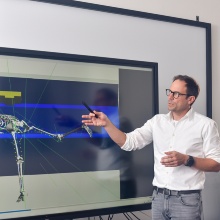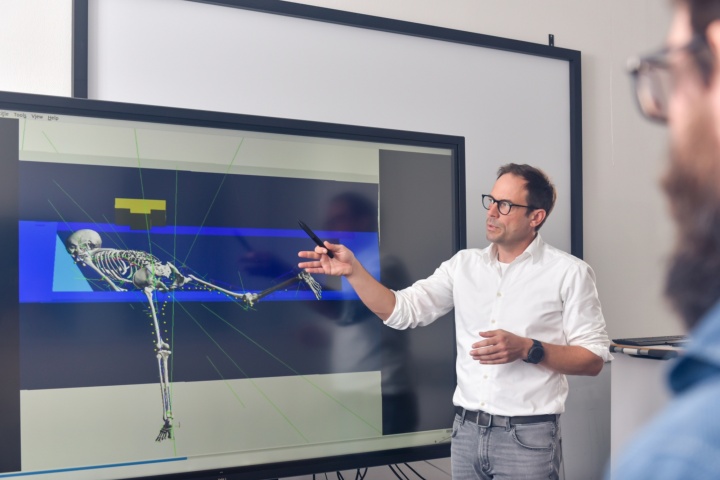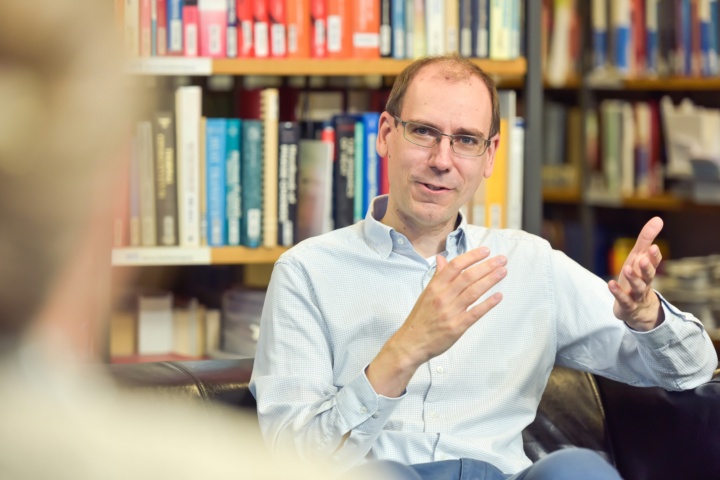Expert testimony from Professors Syn Schmitt and Niels Hansen from the Cluster of Excellence "Data-integrated Simulation Science (EXC 2075, SimTech) at the University of Stuttgart has aided the acquittal of 63-year-old Manfred Genditzki, who spent more than 13 years wrongly imprisoned. Using a new computer-based biomechanical simulation method and thermodynamic calculations, they were able to prove that the then 87-year-old woman could have fallen into her bathtub without any outside interference and died from the consequences of the fall at a time when the defendant had an alibi. This evidence was compelling enough to lead to an acquittal.
"This is the first case in Bavaria, where a life sentence has been revoked as the result of a retrial. Genditzki's acquittal is a historic victory," said Hamburg lawyer Dr. Gerhard Strate. The Stuttgart simulation methods played a significant role in this.
"We are pleased that we were able to make an important contribution to this trial with simulation science," say simulation scientists Prof. Syn Schmitt and Prof. Niels Hansen about the outcome of the trial. Schmitt added, "For the first time, the biomechanical simulation method we co-developed was recognized as evidence in court. This is a great success for our scientific research and especially for the Stuttgart Cluster of Excellence Data-Integrated Simulation Science."
Lieselotte Kortüm was found dead in her bathtub in 2008. The janitor of the housing complex where she lived, Manfred Genditzki, was accused of her murder. Although he was able to refute the original charge of stealing money, he was found guilty of murder. The victim had two bruises on her head, and because of these, it was assumed that a fight had taken place between her and Manfred Genditzki. However, Genditzki the latter protested his innocence throughout.
After four years in prison, lawyer Regina Rick took over Genditzki's defence and, among others, commissioned Professor Syn Schmitt of the University of Stuttgart to provide an expert testimony in order to ensure the case was reopened. Schmitt conducts research on the simulation of biomechanical systems in the SimTech cluster of excellence. He was first requested as an expert witness by the defense counsel during the appeal in 2011, but this was rejected by the court at the time. But in the meantime, the method developed by the Stuttgart scientists was recognized by the Munich Higher Regional Court and this is the first time it has been used in a forensic medical report.
Biomechanical and thermodynamic expert testimonies
In August 2022, after hearing the experts, the Munich I Regional Court ruled that a retrial was justified and that a new hearing must be held. Genditzki, who was convicted of murder and had been in prison for more than 13 years, was released immediately due to a lack of evidence. This was mainly justified by the changing evidence situation, due to the expert biomechanical testimony from Schmitt, and expert testimony on thermodynamics from Professor Niels Hansen, also a simulation scientist at the SimTech Cluster of Excellence. Hansen conducts research on engineering thermodynamics and thermal process engineering and helped narrow down the probable time of death to specific times when the janitor had an alibi.
Numerous simulations created to reconstruct the possible scenarios
Syn Schmitt's team ran numerous simulations to reconstruct possible scenarios in the bathroom. Using the deceased woman's biological data, such as height, weight, specific weight distribution in elderly people, and bone length, the scientists designed a person-specific model and reconstructed what happened. The question was whether a fall without any external influences might lead from the initial position - woman standing in front of the bathtub - to a final position that corresponds to how the victim was found. Final state refers to the body as it lay in the bathtub, with two bruises on the head, the dead person's shoes and a cane in front of the tub.
A pioneering case
All simulations led to the same result: A fall without external impact was probable, meaning the cause of death was likely to have been an accident. "Our method is able to objectively and transparently investigate what movements are possible depending on the laws of physics," explains Syn Schmitt. Niels Hansen's experiments and theoretical calculations to narrow down the water temperature at the time the body was found also exonerated Manfred Genditzki. An established procedure for temperature-based time-of-death estimation based on this established the probable time of death far outside the time of death that had previously been assumed. "The thermodynamic analysis was thus an important component and could be used in other processes," says Niels Hansen on the outcome of the process.
About the Cluster of Excellence "Data-integrated Simulation Science (EXC 2075, SimTech)".
The Cluster of Excellence EXC 2075 "Data-Integrated Simulation Science (SimTech)" is an interdisciplinary research network with more than 200 scientists working together towards one goal: A new class of modeling and computational methods that take the use of simulation and data to a new level and make them available for various applications.
Expert Contact:
Prof. Syn Schmitt and Prof. Niels Hansen are available for interviews.
Contact:
Prof. Syn Schmitt, University of Stuttgart, Institute for Modelling and Simulation of Biomechanical Systems, Tel. +49 711 685 60484, email
Prof. Niels Hansen, UUniversity of Stuttgart, Institute of Thermodynamics and Thermal Process Engineering, Tel. +49 711 685 66112, email
Further information about Prof. Syn Schmitt's research: "Musculature and machinery“, Magazine forschung leben 1/2023
Previous press release from the University of Stuttgart on the case:
"Accident or Murder?", Press release 9/29/2022




